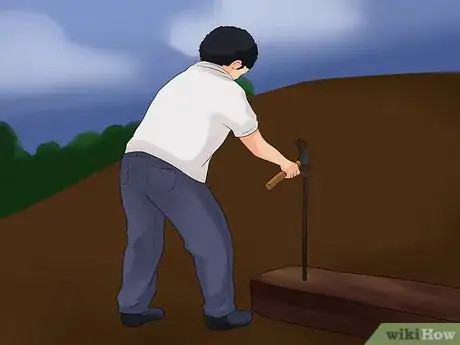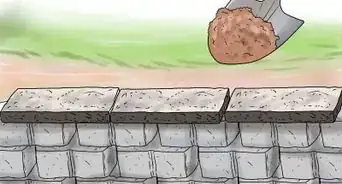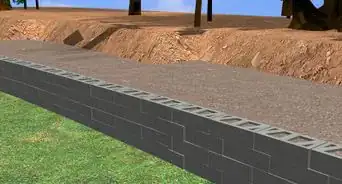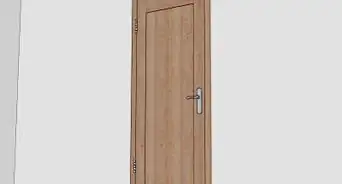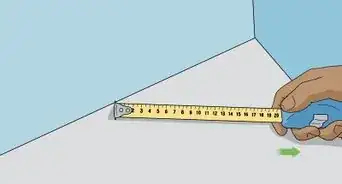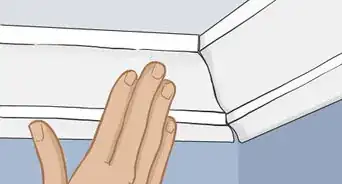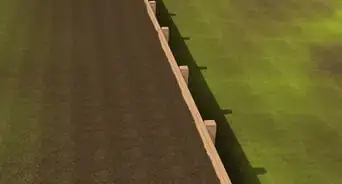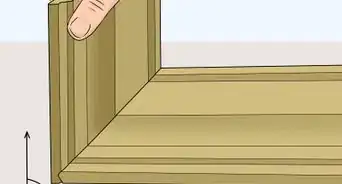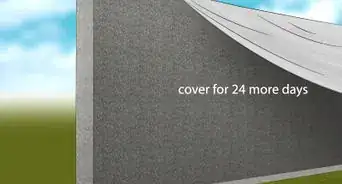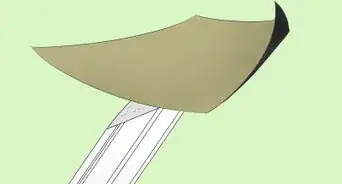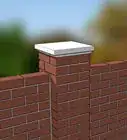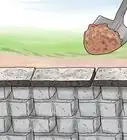This article was co-authored by Grant Wallace. Grant Wallace is a Landscaper and Owner of Grantlanta Lawn in Atlanta, Georgia. With over seven years of experience, he specializes in lawn maintenance and landscape installation. In 2012, he earned his BA from the University of West Georgia. Grant has been profiled in Shoutout Atlanta, Canvas Rebel, and Voyage ATL.
This article has been viewed 193,904 times.
A large sloping backyard may look appealing, but once you start mowing this unusable side hill, you may consider the benefits of getting rid of it. Thus, the thought to build a railroad tie retaining wall comes in. Cutting a large part of a sloping yard out to make room for a livable, usable back yard is a possible solution with the addition of a retaining wall.
Steps
-
1Bulldoze or dig a section of the dirt from the hill out to where you want to build a railroad tie retaining wall.
-
2Level the ground along the entire stretch of hill (so the wall will sit flat) by packing it down evenly with your foot, shovel or a board. Place a level on the surface of the ground to make sure it is level along the entire stretch where the first layer of railroad ties will be placed.Advertisement
-
3Measure the entire length and height of the retaining wall with a tape measure. First measure the length from one end of where you want the wall to sit to the other. Next, measure up from the ground to determine how high you want the wall to be.
-
4Lay the first set of railroad ties out along the prepared ground making sure the ends fit snugly together. Cut any excess off one end of a railroad tie to fit your area if needed.
- Make sure your ties are sitting flush on the ground by setting a level on them periodically throughout the length of the wall to check.
-
5Drill holes about 1 foot (30.48 centimeters) apart through all of the base railroad ties.
- The hole must be big enough to fit a piece of rebar through. The rebar should be at least 2 feet (60.96 centimeters) long.
-
6Put a piece of rebar in each of the holes and hammer it into the ground until the rebar is flush with the top surface of your railroad tie base.
- The rebar acts as your stabilization for the wall.
-
7Start on the second layer once your first layer is in place and stabilized, set your second layer of railroad ties on the first making sure to stagger them like bricks so 2 meet in the middle of a railroad tie above and below it.
- Use nails, L-brackets or rebar to secure each layer to the layer below before adding additional tie layers.
- Each layer will need to be cut individually so the ends of each tie meet at different spots to avoid 2 ends meeting at the same point as the ties above or below it.
- Use nails, L-brackets or rebar to secure each layer to the layer below before adding additional tie layers.
-
8Add support to each level by filling in between the back of the railroad ties and the ground with stones. This will also help with drainage.
Warnings
- Most railroad ties, even those sold as "reclaimed" at home improvement centers, contain creosote. The EPA states that creosote is hazardous, and has no safe use in or around the home. Handling the ties is hazardous to humans, and creosote can leach from the ties for many, many years to harm animals and contaminate ground water and plants. Locate untreated ties (some manufacturers are switching to safer methods than creosote), or use ties that are known to be treated with materials that are safer than creosote.⧼thumbs_response⧽
Things You'll Need
- Shovel or board
- Level
- Tape measure
- Hammer
- Drill
- Chainsaw
- Rebar
- Rocks or stones
- Railroad Ties
- Nails or L-brackets





